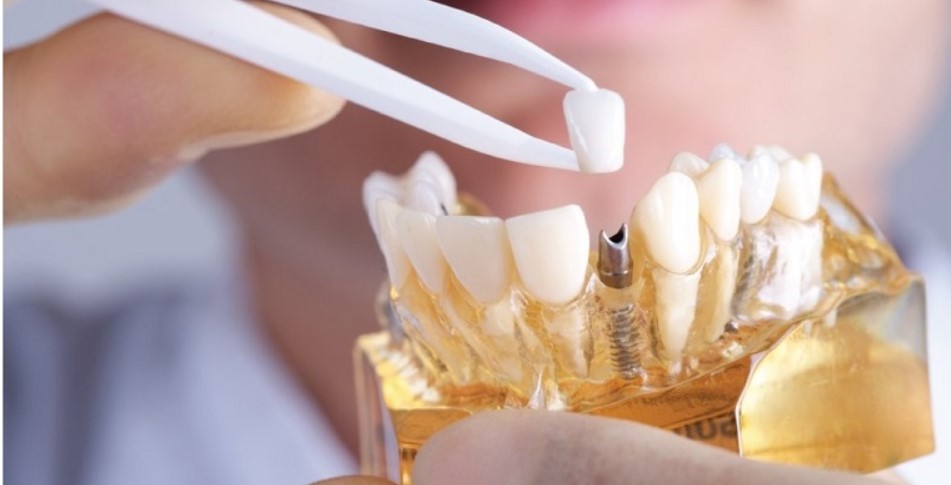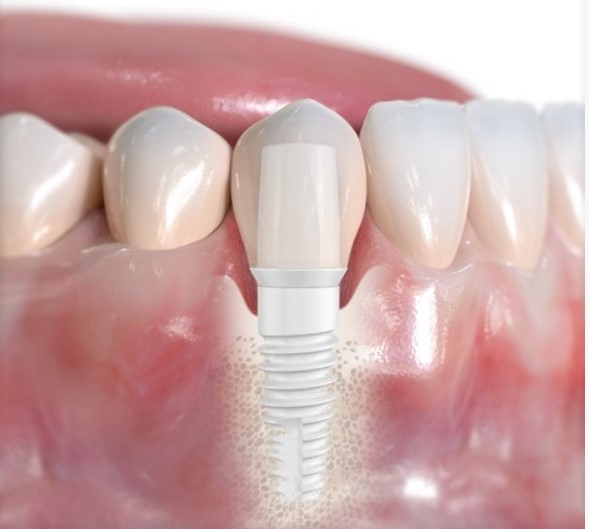Why Ceramic Zirconia Implants
Since the field of dental implantology’s birth in the 1960s, titanium implants have dominated it. That’s why titanium implant systems are so crucial to the field’s development, research, and practice.
The subject of whether and why to pick ceramic implants (in particular zirconia) over titanium implants is a natural one for any dentist thinking about expanding their implant options. We can’t generalize because every situation and patient is different, but if you’re thinking about getting dental implants, here are some things to think about.
Zirconia implants: what are they?
Like titanium implants, ceramic or zirconia dental implants are a one-piece device that is surgically positioned near the gum line. This one-piece construction makes them easier to work with and provides a more streamlined option for surgeons who wish to insert the implant prior to completing the crown. Patients who have had problems with metal implantation in the past may find this helpful, as it eliminates the need to use metal during the treatment.
Implants for teeth composed of ceramic are crafted from zirconia, an oxide of zirconium. Zirconium is a metal that undergoes a structural, naming, and behavioral metamorphosis when an oxide is added to it for use in dentistry. Whiter and more cosmetically attractive than a titanium implant is what you get when you use this method.
More information about Ceramic Implants
Researchers and clinicians are constantly on the lookout for methods to enhance current therapy options. There is ongoing innovation in dentistry, leading to improvements in longevity, predictability, efficiency, and aesthetics. For areas of high esthetic concern or in cases of titanium allergies, the all-ceramic one-piece implant is a fascinating and occasionally controversial invention. Zirconia implants have been produced by a variety of companies, all of which have reported positive results. In areas of thin tissue where implant “show-through” could be an issue, zirconia implants are a more aesthetically pleasing choice, and in many circumstances, the zirconia abutment is also preferable.
Zirconia implants have been around for a while, but that doesn’t stop a number of companies from making them. Their use appears to be spreading among established implant centers.
Zirconia implants have been shown to integrate successfully and to have comparable torque to titanium implants in several trials. One pre-clinical study even suggests that zirconia implants may have a better soft-tissue response.

Is it true that zirconia doesn’t have any metals in it? so exactly how metal-free is zirconia?
Zirconium and zirconium dioxide are two forms of the same element that can be easily confused by both clinicians and patients (zirconia). Is it accurate to say that zirconia implants are “metal free” if zirconium is the primary component? Yes. “Zirconia” refers to a ceramic product made from zirconium dioxide. Zirconium undergoes an irreversible chemical reaction during oxidation in which electrons are transferred from the zirconium atoms to the oxygen molecules. Ceramic zirconia, in contrast to metal zirconium, possesses superior wear resistance, hardness, and conductivity.
This is why metal-free’ is used to define zirconia implants.
The Benefits of Getting Zirconia Dental Implants Instead of Those Made from Metal
- Possessing both high biocompatibility and superior osseointegration, Zirconia, the ceramic substance used to make CeraRoot implants, is biocompatible and promotes full osseointegration (integration with bone). Osseointegration of CeraRoot implants was recently confirmed by a microscopic examination, which found no evidence of inflammation or rejection. Zirconia has been hailed as an excellent choice for dental implants by a number of different researchers.
- Hypersensitivity and other allergen-related disorders CeraRoot zirconia implants, in contrast to metal implants, are not known to cause allergic reactions. Many people who have titanium implants develop sensitivities years after the initial operation, manifesting as itching and irritation at the implant locations. It sets the stage for bone loss and the possible failure of an implant. Because of the rising prevalence of allergies, skin sensitivities, and immune system disorders, it is important to carefully consider the risks and benefits of implanting metal devices, especially titanium implants in the jaw, from the start.
- Esthetics Titanium implants have a cosmetic issue that often emerges. Sometimes the gray gums or titanium can be seen around the crown’s margin in patients with thin, transparent gums or those who are prone to gum recession (like many elderly individuals). Zirconia, being non-metallic and white, looks more like real diamonds than does titanium. It’s a great starting color because it looks just like what Mother Nature intended.
- Defiant against corrosion Zirconia is an inert substance that won’t conduct electricity or heat and is impervious to chemical deterioration. Because it is made of bioinert materials, it will never cause any adverse responses in the body, move to other areas, or prevent good dental hygiene from being practiced. The tale of titanium is different. Titanium implants are known to corrode in the moist conditions of the mouth, and this is especially true if other metals (such as amalgam fillings, alloy metal crowns, bridges, or gold on lays/inlays) are present. Free-flowing fluoride found in some water supplies, toothpaste, and mouthwashes accelerates metal corrosion. Implants made of titanium are directly attacked on their outermost layer. Researchers have found that titanium implants can cause local tissue and lymph node damage.
- Zirconia’s lack of conductivity Zirconia’s high resistance to electrical current is a significant advantage. Zirconia implants are nonconductive, thus bacteria have a much harder time growing on their surfaces, leading to a healthier mouth and more robust gums.
- Holistic-friendly The flow of energy through the body’s meridians is not disrupted by CeraRoot implants. Zirconia implants are ideal for those who take a holistic approach to health since they are inert.
- Strength CeraRoot implants have a high rate of survival over the long term, making this a key benefit of the system. CeraRoot zirconia implants are made to withstand extreme masticatory stresses and look and feel just like natural teeth because to its lifelike shapes and bioinert material. Zirconia’s famed toughness and pressure inflexibility make it a great material for dental implants and other similar applications.
- Integral construction The implant, which is surgically placed into the jawbone, and the abutment, which is attached to the implant above the gumline, are the two metal parts of a conventional titanium implant system. The high pressure of chewing can cause micromovement to occur where these pieces meet, providing warm, wet regions ideal for the colonization of anaerobic bacteria. It sets the stage for a chain reaction that can have disastrous consequences: the bacteria release toxins, causing inflammation surrounding the implant, which can cause bone loss and ultimately implant failure. Due to its clinically proven strength and aesthetic benefits, more ceramic components have been integrated into dentistry during the past few decades. Additionally, biocompatible zirconia implants are now available in a one-piece design, and the use of all-ceramic crowns and implant abutments is becoming more commonplace in treatment programs. CeraRoot implants pave the way for a lifetime of natural health, optimal performance, and dazzling aesthetics.
- Operations performed in a single session For this reason, CeraRoot implants can be placed right after teeth are extracted. The invasiveness of the procedure is reduced to a minimum, and the patient has the greatest possible ease of use. When there is no infection and adequate bone is present at the implant site, a less invasive procedure (one without incisions or suturing) may be possible.
- Comfort Because of the biocompatibility and durability of zirconia, the implant process for CeraRoot patients is shorter, and they may notice considerable improvements in comfort and function afterward. When using CeraRoot, you can rest assured that your plant will thrive for the long haul.
- No Tiny Holes Traditional titanium implants may have tiny gaps after being surgically inserted below the gum line. Zirconia’s one-piece construction means it has fewer microscopic gaps, making it easier to surgically implant.
- A Stronger Connection to Bone When compared to titanium implants, ceramic ones have been proven to have the same or even greater rate of osseointegration with the bone. Those who have had previous implant attempts fail and require a more permanent solution to their dental health problems can benefit greatly from this.
- Reduces the Formation of Plaque Ceramic implants promote oral and general health by preventing plaque and bacteria from adhering to their smooth surface. As a result, the implant is protected from microbial and inflammatory failure.
- Very Long Lasting In comparison to titanium, ceramic has a much longer lifespan. These implants are great for people of all ages and sizes because they can withstand up to 150 pounds of force before breaking and shattering.
- Non-Polar Bacteria will have a harder time attaching to a zirconia implant than it would to a titanium one due to the implant’s non-polar nature. By eliminating the potential for bacterial growth beneath the gums, this method produces a safer implant alternative for the mouth.
- Non-Conductive to Heat Implants made of ceramic are preferable since they do not overheat like metal does. Titanium can and will conduct and retain heat, which could be harmful to the tissues around it. Tissue around the zirconia implant can recover without being compromised.
- Helps Maintain Bone Structure Bone loss around titanium implants has been observed in patients who have had them inserted. In contrast, ceramic implants do not lead to bone deterioration and are hence preferable for long-term surgical applications.
- Cleaner The margins of ceramic implants are positioned at the gum line, while those of titanium implants are positioned below the gum line. The implant can be kept clean and the gum tissue around it can be maintained in good health with the help of this above gum level alternative.
- Definingly No Metallic Aftertaste Titanium is a metal that can corrode and oxidize, leaving your patients with a metallic aftertaste. Zirconia is pure and metal-free, so it won’t leave a bad taste in your mouth after implantation.
These are some of the Positive Effects of Using Ceramic Implants in our Clinic at Smart Dentistry.

Why we use Ceramic Implants at Smart Dentistry?
Dental implants have been successfully used for decades to repair missing teeth because of their unique architecture. Titanium, as all oral surgeons are aware, is the gold standard when it comes to the vast majority of dental procedures, however, zirconia should be preferred over titanium. We at Smart Dentistry a biological or holistic dentistry only use Ceramic or zirconia implants. Our patients are wary about introducing foreign metal into their body and seek out viable, healthy alternatives.
One study found a 97.6 percent success rate among 831 ceramic implants over a five-year period. In the same analysis, it was shown that there were no implant-related problems among the study participants.
Ceramic implants are clearly superior to metal implants in every way. This is why we are replacing titanium implants with zirconia ones, which are easier to keep clean and less likely to harbor bacteria. Ceramic implants have been around for a while, but it is only recently that they have become increasingly popular due to their sleek, unobtrusive appearance. Your patients will appreciate and benefit from the availability of a metal-free option.
How long does it take for a zirconia implant to be firm.
Osseointegration describes the process through which a dental implant becomes firmly anchored in the jaw. Time required to finish this procedure is typically around 6 months. In order to prevent the implant from moving after surgery, a specific amount of torque or primary stability is required. If an implant doesn’t have strong primary stability, it needs to be given three to six months to recover after implantation. Due to its “one-piece” nature, most Zirconia dental implants include an abutment that is fixed to the implant and cannot be removed for healing under the gums.
Unlike titanium dental implants, Zirconia implants are more likely to break. Zirconia is quite strong in compressive pressures but relatively brittle in elastic forces.
Ceramic implant price
The cost of zirconia implants may be affected by the extensive manufacturing process required to create them. It’s important to investigate the production process behind a ceramic implant before committing to it. Manufacturing defects, even minor ones, in the fabrication and surface treatment of a zirconia implant might reduce its strength due to the material’s brittle nature. To ensure clinical success, it is imperative that manufacturers handle the components
